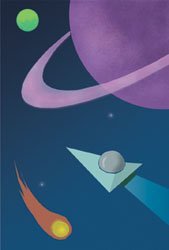Making up their own stories helps students learn material in fresh ways.
It may sound unorthodox, but as a middle school science teacher, I’ve found that one of the best ways to engage students is through creative writing.
When students write research papers, their first instinct is often to collect as many facts as they can into a big pile and string them together into a report. If I am lucky, they will have avoided literally cutting and pasting, but really, how far away from copying is it to regurgitate whatever you have read, changing a few words here and there? What I really want is for students to make ideas their own. I want them to understand their subject as a result of their research—and be able to explain it in a way that makes it fresh.

My favorite tactic for this purpose is to ask them to do some original creative writing. One year, for example, I had them write science fiction stories describing travel to another planet in our solar system. I started with some modeling, reading passages from Arthur Clarke’s classic story, “A Fall of Moondust.” This story was written before the Apollo moon landings, and described a lunar surface very different from what we actually found there. But that was part of the fun. Students could see how Clarke had taken the limited knowledge we had of the moon and woven an adventure around those facts, filling in with imagination wherever the facts were lacking.
I allowed students to choose a planet they wanted to travel to and provided them each with a folder full of information about their planet. I had them do some basic research. What is the atmosphere? Does the planet have a solid surface? Does it have moons? What is the temperature? What resources might we find there? Then comes the challenge. They were asked to write a story describing a trip to this planet. The space travelers would need to be equipped to survive on the planet, and the story would need to include as many science details as possible.
My students had a lot of fun with this assignment. Some were more artistic, so I allowed them to create cartoon-style stories, illustrating the adventure, with dialogue written in bubbles over the characters’ heads. Others wrote elaborate soap operas, with characters living out the dramatic lives typical of a teenager. Planetary facts were not always foremost in their work, but the rubric gave them points for creatively incorporating as many facts as possible.
This strategy, of course, is easily adapted to math, social studies, and other content areas beyond English and language arts. Also, if you’re looking for ways to integrate digital tools like blogs, wikis, podcasts, or photostory into your classsroom, this kind of imaginative writing activity can be easily adapted to those environments. Here are some other writing-project ideas in science:
• A first-person diary describing a day in the life of your favorite animal—with information about habitat, predator-prey interactions, and survival strategies.
• A first-person account of a major volcanic eruption, such as Mount St. Helens, including all relevant scientific details, the type of volcano, the nature of the eruption, the damage done, and so on.
• A story describing the journey of a bite of food from the mouth on downward, with details showing all the steps along the way (this makes a great comic strip or first-person account).
• A children’s book explaining acids and bases so that a 4th grader could understand, using examples of chemical reactions, and diagrams showing how the reactions occur.
• With due credit to H.G. Wells, a story about a trip back in time to the Jurassic or any other era, describing the plants, animals, and topography of the time.
• And with a nod to Jules Verne, a scientifically accurate journey to the center of the earth, describing the characteristics of each layer one would encounter.
For each of these projects, I would scaffold the research by providing students with reference materials, books, and articles I have already printed out from the Internet. This gives them the basic information they need and cuts down on Web-surfing time. Allowing them to choose from several options increases their enthusiasm and sense of ownership. Their challenge is to make the facts come alive, through their own imaginations.
The results are a wide variety of projects, reflecting the diverse interests and talents of the students.





